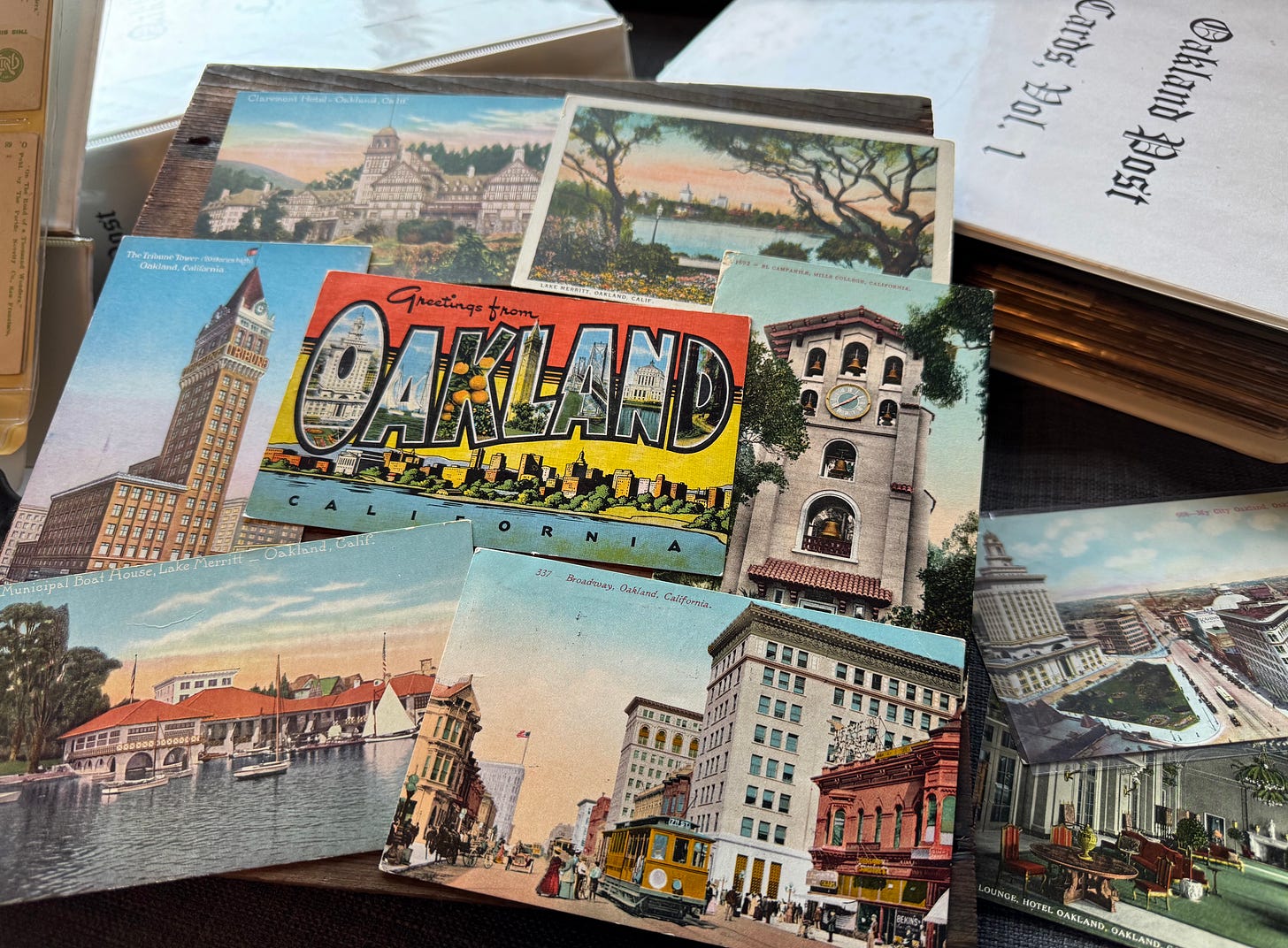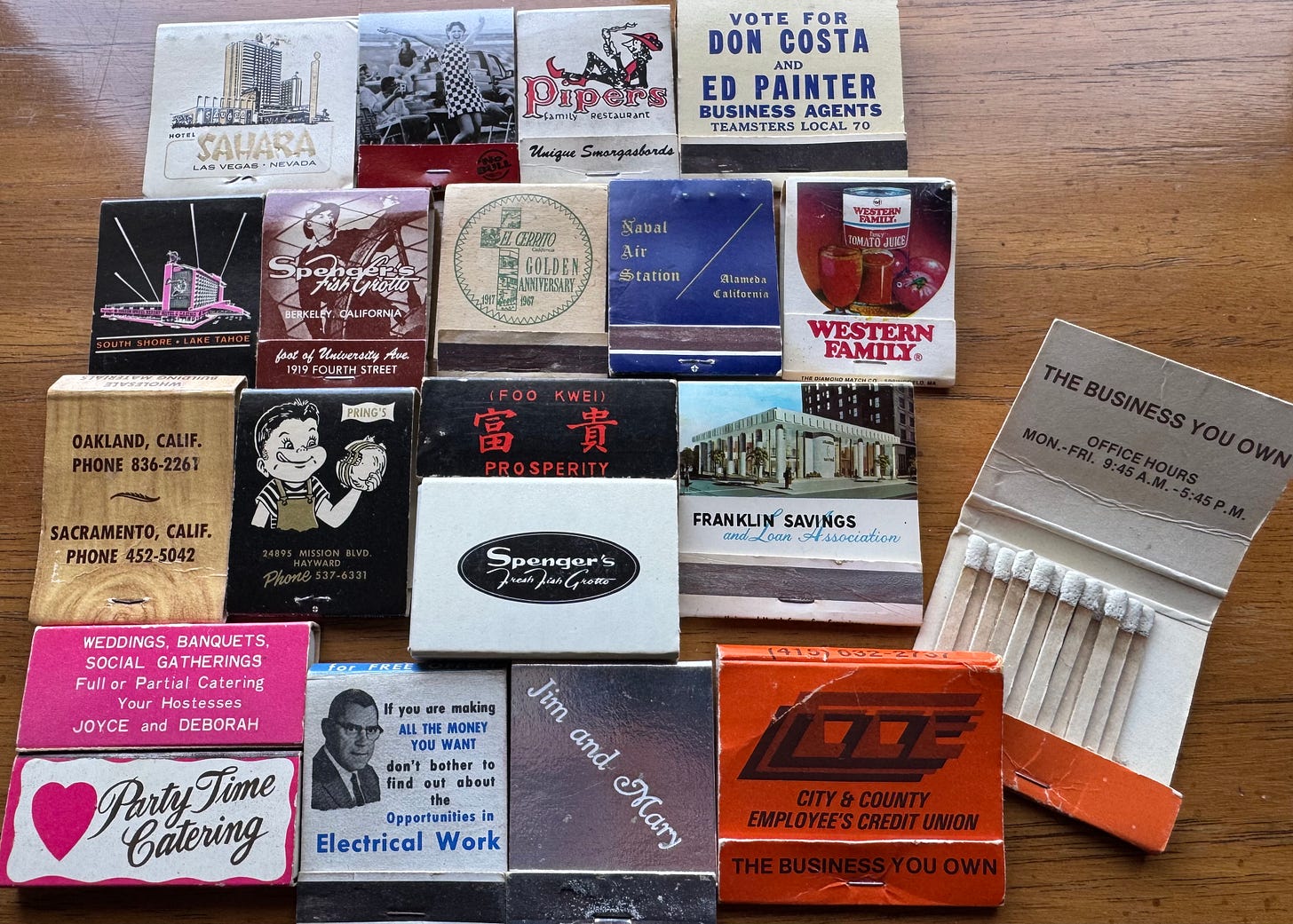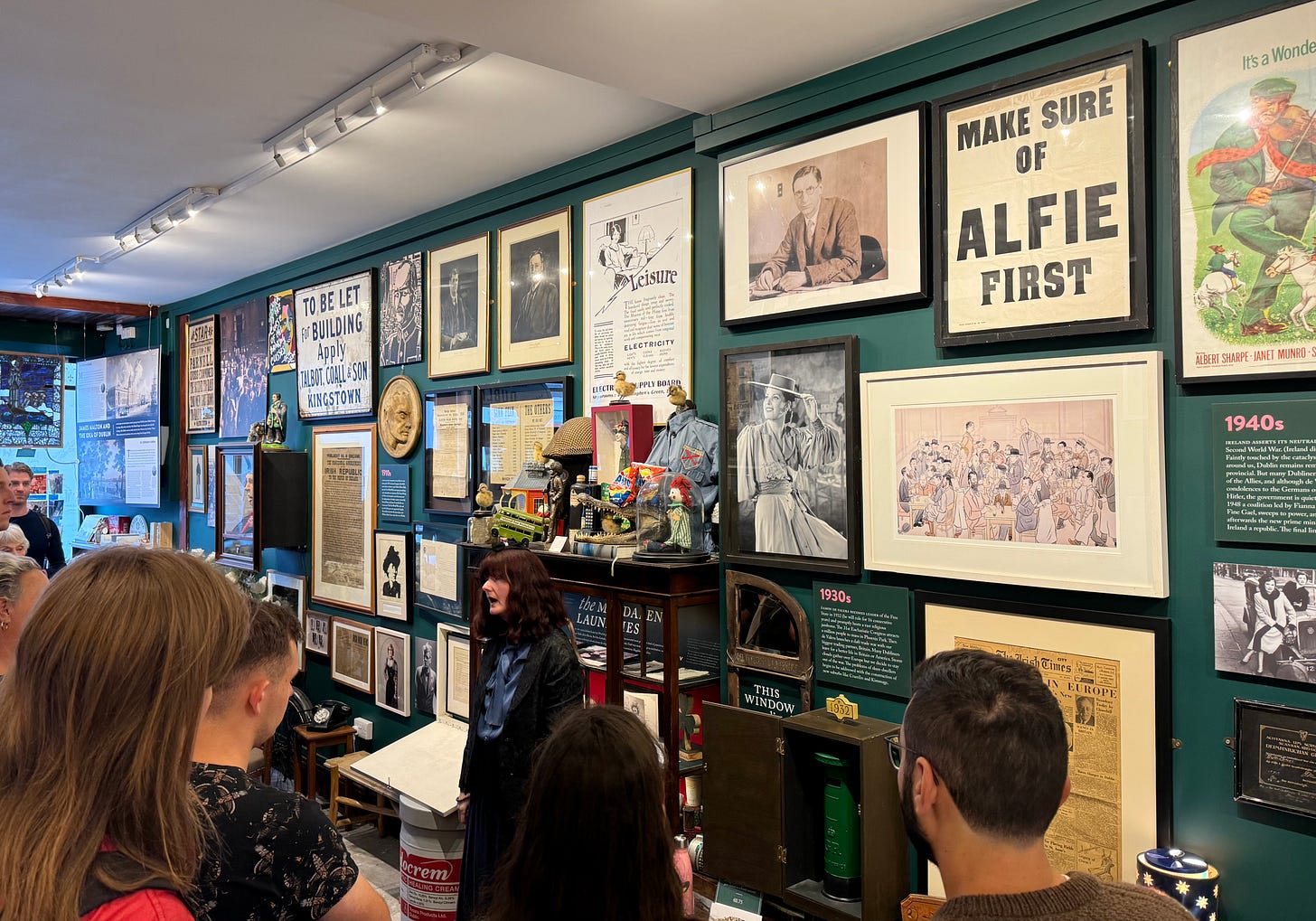I’m building an accidental archive
Sometimes objects convey history in ways that a screen never could

When I started the East Bay Yesterday podcast in 2016, my goal was to collect stories. I wanted to understand and celebrate the history of this region by interviewing people and publishing those conversations. Somehow, along the way, I started accumulating a growing pile of stuff. I didn’t set out to gather physical objects, but once word got out that I was interested in local history, people started giving me things – vintage postcards, matchbooks from long-gone restaurants, a chunk of the old Bay Bridge. While I was attempting to clean my office this week, I had to confront the fact that I’m building an accidental archive.
Some aspects of my archive are more intentional than others. While I deeply appreciate the vast collection of books at the Oakland History Center, the convenience and utility of having a personal library of East Bay history books three feet from my desk gives me a ridiculous amount of satisfaction. At least once a day, I’ll think of some obscure fact I want to check or a photo I want to review and all I need to do is swivel my chair 180 degrees. The practicality of having so much relevant knowledge at my fingertips can’t be overstated.
I purchased many of these books, but lots of them (especially the obscure ones and photography books) were given to me by people who were getting rid of them and wanted to make sure they found a good home. They did!
Similar to my library, my filing cabinet full of bulging folders serves as a ready storehouse of information. The contents of these folders generally aren’t items that I look at very often, but, taken together, they form a paper trail of bygone events, tours, and locations. One folder is filled with brochures and maps from all the various historical walking tours I’ve attended. Another folder is stuffed with flyers and programs from various happenings – protests, conferences, the Black Panthers’ 50th Anniversary Celebration. Especially now that most events are advertised solely through Eventbrite, Instagram, and Facebook, I worry how future historians will study our era after all those links go dead.
The crown jewel of my archives is one of the most generous gifts I’ve ever received. A few years ago, I got an email from a listener named Bill who told me that he had a massive collection of historic East Bay postcards sitting in his 99-year-old mother’s garage in Pasadena… did I want them? (YES!) Since I met with Bill to accept his donation – five large, well-organized binders filled with vintage images of local landmarks – I’ve flipped through those binders countless times.
Once I brought a binder to an event at Camron-Stanford House, a restored Victorian mansion next to Lake Merritt, and a long line formed of people patiently waiting their turn to peruse the postcards. As I was chatting with folks that day, peoples’ reaction to spending time with the collection was similar to mine: it felt like time-traveling. Because the images were printed on real postcards (often with messages written on the back), the objects had a certain aura, like each paper rectangle was a small window into the past, a tiny portal to a different era.
Sometimes when I’m researching a topic, the first place I’ll look for inspiration is the postcards. For example, the Idora Park postcards (seen above) not only depict the rides, but also the crowds. Seeing men and women at an amusement park wearing suits and fancy dresses highlighted the cultural differences that separate our time with the early 1900s. Thinking about these differences made me want to delve deeper into the psychological chasm that separates our eras, as well. How could these dapper gentlemen and genteel ladies be attracted to the spectacle of watching a horse jump off a high dive into a small pool? (Yes, that really happened.) I might not have explored this question in the podcast if that train of thought hadn’t been set in motion by contemplating the postcards.
Over the years, I’ve turned down plenty of well-intentioned donations. Several listeners clearing out attics and storage units of recently deceased relatives have offered me old high school yearbooks, piles of crumbling newspapers, and even phonebooks. I’m such a history nerd that I probably would enjoy a leisurely afternoon spent paging through a mid-century Yellow Pages, but my office has limited space… and I try to remain vigilant about not straying from “archivism” into hoarder territory. Sometimes the line is blurry. I gladly accepted a box full of old matchbooks a few months ago (thanks, Paul!) even though I have no idea what to do with them. They aren’t very much help with research, but some of them look pretty cool, so they’re staying on my shelf. Maybe if I get enough of them I’ll curate an exhibition someday…
If the archive ever outgrows my office, I might be forced to open a mini-museum. This may sound ridiculous, but when I visited Dublin (Ireland, not eastern Alameda County) one of my favorite experiences was exploring The Little Museum. The concept was simple: A single room, filled to the brim with paraphernalia and objects representing different aspects of Irish history. The “tour” consisted of a docent walking around the room, pointing at things, and sharing entertaining anecdotes. I don’t plan on stopping my boat tours of the San Francisco Bay any time soon, but I do see the benefits of doing a “one-room tour,” like better accessibility and less bird poop.
I know that all this may sound quaint, even outdated, in a world that’s embracing artificial intelligence and augmented reality, but I’m still skeptical that these new tools will be better than the traditional ways of passing down history. Sure, a ChatGPT summary could give you the facts about, say, World War II, but going on an excursion into the bowels of the USS Hornet aircraft carrier literally lets you walk in the footsteps of the men who fought that war. History isn’t just data, it’s the feel of a delicately folded letter still smelling faintly of perfume. It’s tangible in ways that a screen, or a robotic voice, could never convey. At least that’s what I’m telling myself as I pack away a box filled with homemade zines, a quilt, photos, some coins, and memories that seem to come bursting back out every time I reopen the box.
East Bay Yesterday news
Who wants to come on one of my historical boat tours? I just added a few more dates: June 27, July 19, and August 10. Expect to hear stories, see ospreys, and hopefully enjoy a beautiful sunset. See my FAQ page for more details. (PS: You can get a taste of the tour by checking out the photos that accompany this AP article on how salmon boats are staying in business despite severe fishing restrictions.)
New podcast: There’s an area southeast of Lake Merritt that’s lined with abandoned buildings, boarded up storefronts, vacant lots, and decrepit warehouses. The neighborhoods here, Clinton and San Antonio, are some of Oakland’s oldest. Although there are also beautiful Victorian houses, long-established churches, and several thriving immigrant communities, including a stretch of Vietnamese establishments known as Little Saigon, this area has suffered from disinvestment and high crime rates for decades – why? Listen to my interview with “Hella Town” author Mitchell Schwarzer to find out. [Hear it via Apple, SoundCloud, Spotify, or wherever you get podcasts.]
My latest SF Gate article, “The world’s largest collection of punk records is leaving the Bay for Tennessee,” covers the history of Maximum Rocknroll. Long before I started East Bay Yesterday, my first effort in self-publishing was a zine about the Chicago punk scene back when I was in high school. I still remember how elated I was to see my little zine reviewed in the pages of MRR, the unquestionable authority on underground punk culture. Exploring the archives of this iconoclastic publication almost felt like retracing the steps of a former life. Like many aging punks, I’m sad to see MRR’s legendary record collection leave the Bay, but at least it’s going to an academic institution that has promised to keep the archive safe and publicly accessible.
You’ll be hearing more about this in the coming months, but for a good overview on the Oakland History Center’s diorama contest, check out this Oaklandside article. I’ll be hosting a trivia competition as part of the festivities, but the main event will be the miniature displays of local history. I can’t wait to see the concepts people come up with. If you’re a crafty history nerd, this will be your time to shine!
More Local History News
Closing out this month’s newsletter, here are a few local history-related articles that I’ve appreciated recently…
Archiving Oakland [Places Journal]
Akiba’s dream becomes the legend of Yoshi’s [East Bay Express]
Nat Bolden: Bay Area blues singer [East Bay Times]
The story behind the Chappell Hayes Observation Tower [Mercury News]
Bob Marley’s last night in Oakland [38th Notes (via Wayback Machine)]
The little Bay Area theme park that helped build Disneyland [SF Gate]
A Jazz Age junket from West Oakland [Ice City Almanac]
Finally, I want to end with a quick recommendation: If you’re looking for an extremely well-curated weekly digest of upcoming artsy/literary/political events, check out the Oakland Review of Books.
Thanks for reading!
Liam
OK, fine, here’s one more from the postcard collection. Cities looked so much cooler when there was neon everywhere, right?!










Thanks for the big images! I hope the postcards can be scanned somehow.
I pay archive.org every month to help keep the electronic past alive. Our libraries, as you say, are irreplaceable too. I say if it's already online, don't collect the paper. (Says the guy with a stubborn rock collection.)
Just remember: with great archives come great responsibilities. Seriously, have a plan on where it should eventually go. I’m working on my plan.